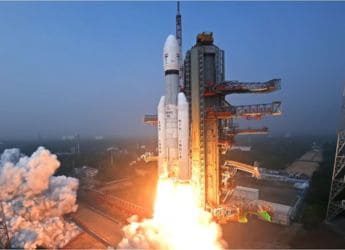- Home
- Science
- Science News
- Ariane 6 Launches Metop SGA1 Weather Satellite into Polar Orbit
Ariane 6 Launches Metop-SGA1 Weather Satellite into Polar Orbit
On Aug. 12, 2025, Europe’s Ariane 6 rocket launched Metop-SGA1, a next-gen polar-orbiting weather satellite, from French Guiana. The mission, Ariane 6’s third flight, will enhance climate monitoring and forecasting worldwide.

Photo Credit: Arianespace
Ariane 6 launches Metop-SGA1 weather satellite from French Guiana successfully
Ariane 6, Europe's heavy-lift rocket made it's third successful lift-off from from Kourou, French Guiana on August 12 at 8:37 p.m. EDT. This time, it's payload is Metop-SGA1, an 8,900-pound (4,040-kilogram) weather satellite that will be operated by the international group EUMETSAT (European Organisation for the Exploitation of Meteorological Satellites). After liftoff, Ariane 6 placed the payload into a 500-mile-high (800 km) polar orbit roughly 64 minutes later. In its first commercial mission in March 2025, Ariane 6 carried a French spy satellite.
Ariane 6
According to official websites, Ariane 6, the successor to the recently retired Ariane 5, is built by the French company ArianeGroup and operated by its subsidiary Arianespace on behalf of European Space Agency. It is a two stage rocket which has a Vulcain 2.1 engine (an evolved variant of the Ariane 5's Vulcain 2, an evolved variant of the Ariane 5's Vulcain 2) powered first stage, and its upper stage features one Vinci engine, which is new technology.
The rocket made its debut with a test flight in July 2024 and flew again this past March, successfully sending a French spy satellite to Earth orbit on the rocket's first-ever commercial mission.
About the Payload
The Metop-SGA1 (Second Generation A1) satellite is the first of the next generation of European polar-orbiting weather satellites. Metop-SGA1 will host a total of six atmospheric sounding and imaging instrument missions that will provide optical, infrared, and microwave observations essential data for weather forecasting, climate monitoring, and a wide range of other services and applications. Amongst its hosts, Metop-SGA1 carries the new Sentinel-5 atmospheric monitoring mission, part of the European Commission's Copernicus programme.
The satellite will take global observation of weather and climate from a polar orbit to a new level, providing high resolution observations of temperature, precipitation, clouds, winds, sea ice, aerosols, pollution, soil moisture, volcanic dust, and a multitude of other parameters.
(Disclaimer: New Delhi Television is a subsidiary of AMG Media Networks Limited, an Adani Group Company.)
Get your daily dose of tech news, reviews, and insights, in under 80 characters on Gadgets 360 Turbo. Connect with fellow tech lovers on our Forum. Follow us on X, Facebook, WhatsApp, Threads and Google News for instant updates. Catch all the action on our YouTube channel.
Related Stories
- Samsung Galaxy Unpacked 2025
- ChatGPT
- Redmi Note 14 Pro+
- iPhone 16
- Apple Vision Pro
- Oneplus 12
- OnePlus Nord CE 3 Lite 5G
- iPhone 13
- Xiaomi 14 Pro
- Oppo Find N3
- Tecno Spark Go (2023)
- Realme V30
- Best Phones Under 25000
- Samsung Galaxy S24 Series
- Cryptocurrency
- iQoo 12
- Samsung Galaxy S24 Ultra
- Giottus
- Samsung Galaxy Z Flip 5
- Apple 'Scary Fast'
- Housefull 5
- GoPro Hero 12 Black Review
- Invincible Season 2
- JioGlass
- HD Ready TV
- Laptop Under 50000
- Smartwatch Under 10000
- Latest Mobile Phones
- Compare Phones
- Honor Win RT
- Honor Win
- Xiaomi 17 Ultra Leica Edition
- Xiaomi 17 Ultra
- Huawei Nova 15
- Huawei Nova 15 Pro
- Huawei Nova 15 Ultra
- OnePlus 15R
- Asus ProArt P16
- MacBook Pro 14-inch (M5, 2025)
- OPPO Pad Air 5
- Huawei MatePad 11.5 (2026)
- Xiaomi Watch 5
- Huawei Watch 10th Anniversary Edition
- Acerpure Nitro Z Series 100-inch QLED TV
- Samsung 43 Inch LED Ultra HD (4K) Smart TV (UA43UE81AFULXL)
- Asus ROG Ally
- Nintendo Switch Lite
- Haier 1.6 Ton 5 Star Inverter Split AC (HSU19G-MZAID5BN-INV)
- Haier 1.6 Ton 5 Star Inverter Split AC (HSU19G-MZAIM5BN-INV)
-
 New Electrochemical Method Doubles Hydrogen Output While Cutting Energy Costs
New Electrochemical Method Doubles Hydrogen Output While Cutting Energy Costs
-
 JWST Spots Most Distant Supernova Ever, From 730 Million Years After Big Bang
JWST Spots Most Distant Supernova Ever, From 730 Million Years After Big Bang
-
 ISRO Plans Third Launch Pad at Sriharikota in Four Years to Support Heavier Satellites
ISRO Plans Third Launch Pad at Sriharikota in Four Years to Support Heavier Satellites
-
 ISS Microgravity Experiment Reveal How Particles Behave Without Gravity
ISS Microgravity Experiment Reveal How Particles Behave Without Gravity










